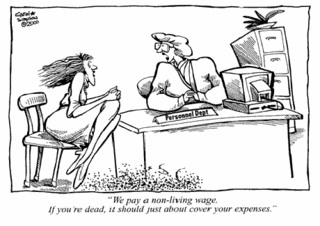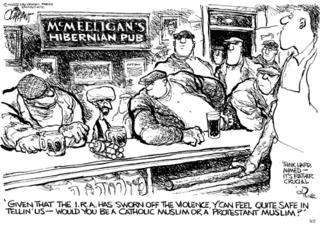Ten Most Harmful Books of the 19th and 20th Centuries
Posted May 31, 2005
HUMAN EVENTS asked a panel of 15 conservative scholars and public policy leaders to help us compile a list of the Ten Most Harmful Books of the 19th and 20th Centuries. Each panelist nominated a number of titles and then voted on a ballot including all books nominated. A title received a score of 10 points for being listed No. 1 by one of our panelists, 9 points for being listed No. 2, etc. Appropriately, The Communist Manifesto, by Karl Marx and Friedrich Engels, earned the highest aggregate score and the No. 1 listing.
1. The Communist Manifesto
Authors: Karl Marx and Freidrich Engels
Publication date: 1848
Score: 74
Summary: Marx and Engels, born in Germany in 1818 and 1820, respectively, were the intellectual godfathers of communism. Engels was the original limousine leftist: A wealthy textile heir, he financed Marx for much of his life. In 1848, the two co-authored The Communist Manifesto as a platform for a group they belonged to called the Communist League. The Manifesto envisions history as a class struggle between oppressed workers and oppressive owners, calling for a workers’ revolution so property, family and nation-states can be abolished and a proletarian Utopia established. The Evil Empire of the Soviet Union put the Manifesto into practice.
2. Mein Kampf
Author: Adolf Hitler
Publication date: 1925-26
Score: 41
Summary: Mein Kampf (My Struggle) was initially published in two parts in 1925 and 1926 after Hitler was imprisoned for leading Nazi Brown Shirts in the so-called “Beer Hall Putsch” that tried to overthrow the Bavarian government. Here Hitler explained his racist, anti-Semitic vision for Germany, laying out a Nazi program pointing directly to World War II and the Holocaust. He envisioned the mass murder of Jews, and a war against France to precede a war against Russia to carve out “lebensraum” (“living room”) for Germans in Eastern Europe. The book was originally ignored. But not after Hitler rose to power. According to the Simon Wiesenthal Center, there were 10 million copies in circulation by 1945.
3. Quotations from Chairman Mao
Author: Mao Zedong
Publication date: 1966
Score: 38
Summary: Mao, who died in 1976, was the leader of the Red Army in the fight for control of China against the anti-Communist forces of Chiang Kai-shek before, during and after World War II. Victorious, in 1949, he founded the People’s Republic of China, enslaving the world’s most populous nation in communism. In 1966, he published Quotations from Chairman Mao Zedong, otherwise known as The Little Red Book, as a tool in the “Cultural Revolution” he launched to push the Chinese Communist Party and Chinese society back in his ideological direction. Aided by compulsory distribution in China, billions were printed. Western leftists were enamored with its Marxist anti-Americanism. “It is the task of the people of the whole world to put an end to the aggression and oppression perpetrated by imperialism, and chiefly by U.S. imperialism,” wrote Mao.
4. The Kinsey Report
Author: Alfred Kinsey
Publication date: 1948
Score: 37
Summary: Alfred Kinsey was a zoologist at Indiana University who, in 1948, published a study called Sexual Behavior in the Human Male, commonly known as The Kinsey Report. Five years later, he published Sexual Behavior in the Human Female. The reports were designed to give a scientific gloss to the normalization of promiscuity and deviancy. “Kinsey’s initial report, released in 1948 . . . stunned the nation by saying that American men were so sexually wild that 95% of them could be accused of some kind of sexual offense under 1940s laws,” the Washington Times reported last year when a movie on Kinsey was released. “The report included reports of sexual activity by boys--even babies--and said that 37% of adult males had had at least one homosexual experience. . . . The 1953 book also included reports of sexual activity involving girls younger than age 4, and suggested that sex between adults and children could be beneficial.”
5. Democracy and Education
Author: John Dewey
Publication date: 1916
Score: 36
Summary: John Dewey, who lived from 1859 until 1952, was a “progressive” philosopher and leading advocate for secular humanism in American life, who taught at the University of Chicago and at Columbia. He signed the Humanist Manifesto and rejected traditional religion and moral absolutes. In Democracy and Education, in pompous and opaque prose, he disparaged schooling that focused on traditional character development and endowing children with hard knowledge, and encouraged the teaching of thinking “skills” instead. His views had great influence on the direction of American education--particularly in public schools--and helped nurture the Clinton generation.
6. Das Kapital
Author: Karl Marx
Publication date: 1867-1894
Score: 31
Summary: Marx died after publishing a first volume of this massive book, after which his benefactor Engels edited and published two additional volumes that Marx had drafted. Das Kapital forces the round peg of capitalism into the square hole of Marx’s materialistic theory of history, portraying capitalism as an ugly phase in the development of human society in which capitalists inevitably and amorally exploit labor by paying the cheapest possible wages to earn the greatest possible profits. Marx theorized that the inevitable eventual outcome would be global proletarian revolution. He could not have predicted 21st Century America: a free, affluent society based on capitalism and representative government that people the world over envy and seek to emulate.
7. The Feminine Mystique
Author: Betty Friedan
Publication date: 1963
Score: 30
Summary: In The Feminine Mystique, Betty Friedan, born in 1921, disparaged traditional stay-at-home motherhood as life in “a comfortable concentration camp”--a role that degraded women and denied them true fulfillment in life. She later became founding president of the National Organization for Women. Her original vocation, tellingly, was not stay-at-home motherhood but left-wing journalism. As David Horowitz wrote in a review for Salon.com of Betty Friedan and the Making of the Feminine Mystique by Daniel Horowitz (no relation to David): The author documents that “Friedan was from her college days, and until her mid-30s, a Stalinist Marxist, the political intimate of the leaders of America’s Cold War fifth column and for a time even the lover of a young Communist physicist working on atomic bomb projects in Berkeley’s radiation lab with J. Robert Oppenheimer.”
8. The Course of Positive Philosophy
Author: Auguste Comte
Publication date: 1830-1842
Score: 28
Summary: Comte, the product of a royalist Catholic family that survived the French Revolution, turned his back on his political and cultural heritage, announcing as a teenager, “I have naturally ceased to believe in God.” Later, in the six volumes of The Course of Positive Philosophy, he coined the term “sociology.” He did so while theorizing that the human mind had developed beyond “theology” (a belief that there is a God who governs the universe), through “metaphysics” (in this case defined as the French revolutionaries’ reliance on abstract assertions of “rights” without a God), to “positivism,” in which man alone, through scientific observation, could determine the way things ought to be.
9. Beyond Good and Evil
Author: Freidrich Nietzsche
Publication date: 1886
Score: 28
Summary: An oft-scribbled bit of college-campus graffiti says: “‘God is dead’--Nietzsche” followed by “‘Nietzsche is dead’--God.” Nietzsche’s profession that “God is dead” appeared in his 1882 book, The Gay Science, but under-girded the basic theme of Beyond Good and Evil, which was published four years later. Here Nietzsche argued that men are driven by an amoral “Will to Power,” and that superior men will sweep aside religiously inspired moral rules, which he deemed as artificial as any other moral rules, to craft whatever rules would help them dominate the world around them. “Life itself is essentially appropriation, injury, overpowering of the strange and weaker, suppression, severity, imposition of one’s own forms, incorporation and, at the least and mildest, exploitation,” he wrote. The Nazis loved Nietzsche.
10. General Theory of Employment, Interest and Money
Author: John Maynard Keynes
Publication date: 1936
Score: 23
Summary: Keynes was a member of the British elite--educated at Eton and Cambridge--who as a liberal Cambridge economics professor wrote General Theory of Employment, Interest and Money in the midst of the Great Depression. The book is a recipe for ever-expanding government. When the business cycle threatens a contraction of industry, and thus of jobs, he argued, the government should run up deficits, borrowing and spending money to spur economic activity. FDR adopted the idea as U.S. policy, and the U.S. government now has a $2.6-trillion annual budget and an $8-trillion dollar debt.
Honorable Mention
These books won votes from two or more judges:
The Population Bomb
by Paul Ehrlich
Score: 22
What Is To Be Done
by V.I. Lenin
Score: 20
Authoritarian Personality
by Theodor Adorno
Score: 19
On Liberty
by John Stuart Mill
Score: 18
Beyond Freedom and Dignity
by B.F. Skinner
Score: 18
Reflections on Violence
by Georges Sorel
Score: 18
The Promise of American Life
by Herbert Croly
Score: 17
The Origin of Species
by Charles Darwin
Score: 17
Madness and Civilization
by Michel Foucault
Score: 12
Soviet Communism: A New Civilization
by Sidney and Beatrice Webb
Score: 12
Coming of Age in Samoa
by Margaret Mead
Score: 11
Unsafe at Any Speed
by Ralph Nader
Score: 11
Second Sex
by Simone de Beauvoir
Score: 10
Prison Notebooks
by Antonio Gramsci
Score: 10
Silent Spring
by Rachel Carson
Score: 9
Wretched of the Earth
by Frantz Fanon
Score: 9
Introduction to Psychoanalysis
by Sigmund Freud
Score: 9
The Greening of America
by Charles Reich
Score: 9
The Limits to Growth
by Club of Rome
Score: 4
Descent of Man
by Charles Darwin
Score: 2
The Judges
These 15 scholars and public policy leaders served as judges in selecting the Ten Most Harmful Books.
Arnold Beichman
Research Fellow
Hoover Institution
Prof. Brad Birzer
Hillsdale College
Harry Crocker
Vice President & Executive Editor
Regnery Publishing, Inc.
Prof. Marshall DeRosa
Florida Atlantic University
Dr. Don Devine
Second Vice Chairman
American Conservative Union
Prof. Robert George
Princeton University
Prof. Paul Gottfried
Elizabethtown College
Prof. William Anthony Hay
Mississippi State University
Herb London
President
Hudson Institute
Prof. Mark Malvasi
Randolph-Macon College
Douglas Minson
Associate Rector
The Witherspoon Fellowships
Prof. Mark Molesky
Seton Hall University
Prof. Stephen Presser
Northwestern University
Phyllis Schlafly
President
Eagle Forum
Fred Smith
President
Competitive Enterprise Institute












